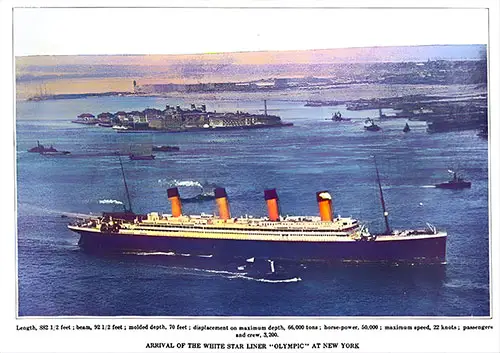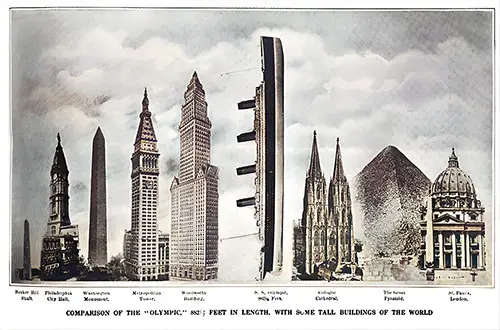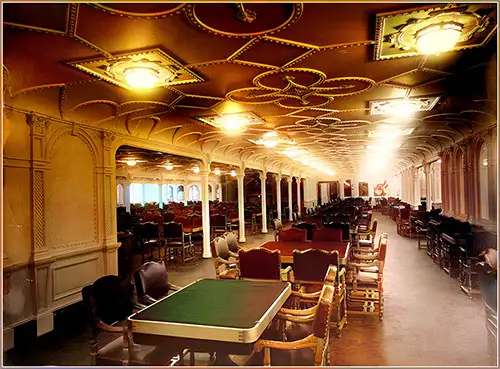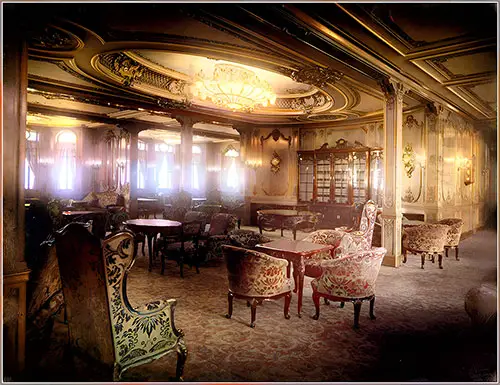Olympic’s Sea Trials & Maiden Voyage: Engineering, Performance, and Legacy of Titanic’s Sister Ship
📌 Explore the Olympic’s sea trials, maiden voyage, and groundbreaking engineering. A must-read for Titanic researchers, maritime historians, and ocean travel enthusiasts.
The Shipbuilder – Olympic Sea Trials and Maiden Voyage ⚓🚢
Introduction: A Defining Moment in Ocean Travel
The Olympic sea trials and maiden voyage represent a pivotal chapter in maritime history. This section of The Shipbuilder (1911) provides an in-depth account of the testing, performance, and early service of the Titanic's sister ship, the Olympic. It offers valuable insights into the engineering, logistics, and operational aspects of one of the largest and most advanced ships of the time.
For teachers, students, genealogists, and historians, this article serves as a critical primary source for studying the development of transatlantic liners, the White Star Line’s ambitions, and the maritime technology of the early 20th century. The Olympic’s trials foreshadow the Titanic’s journey, making this an essential resource for understanding the era’s engineering triumphs and shortcomings.
The 31st May, 1911, will remain notable in the annals of shipbuilding and ship owning as witnessing the launch of the Titanic and the departure from Belfast of the Olympic, two vessels which may truly be said to mark an intensely interesting epoch in the history of the mercantile marine.
Together they represent an addition to the world’s merchant shipping of about 90,000 gross tons and a capital outlay of some three millions sterling, while for the White Star Line there are now waterborne the two largest steamships so far constructed.
On the 2nd May, the Olympic Trials of the underwent her basin engines being turned while the vessel was securely moored in the deep-water fitting-out basin, and this preliminary test, proved entirely satisfactory.
Prior to leaving for her trials at sea, the ship was thrown open for public inspection, and some thousands of visitors paid 5s. each during the first two hours and 2s. for the remaining three hours, the proceeds—a very considerable sum— being handed to the Belfast hospitals.
![]()
Fig. 146: The Olympic on Trial Trip. The Shipbuilder, Midsummer 1911. | GGA Image ID # 10e523fbd3
The 31st May 1911 will remain notable in the annals of shipbuilding and ship owning as witnessing the launch of the SS Titanic and the departure from Belfast of the SS Olympic. These two vessels mark an intensely interesting epoch in the history of the mercantile marine.
Together, they represent an addition to the world's merchant shipping of about 90,000 gross tons and a capital outlay of some three million sterling. At the same time, the White Star Line is now the two largest steamships so far constructed.
On 2 May, the SS Olympic Trials underwent basin trials, the "Olympic." engines being turned while the vessel was securely moored in the deep-water fitting-out basin, and this preliminary test proved entirely satisfactory.
Before leaving for her trials at sea, the ship was opened for public inspection. Some thousands of visitors paid 5s each during the first two hours and 2s for the remaining three hours, the proceeds of which—a considerable sum—were handed to the Belfast hospitals.
The SS Olympics' sea trials were meticulously planned and executed. The ship took on 3,000 tons of the best Welsh coal, and 250 runners were sent over from Liverpool to assist in navigating the vessel, a testament to the precision and dedication of the shipbuilders.
At high water on the morning of the 28 May, the task of swinging the liner was entered upon the Mersey tugs Wallasey, Alexandra, Hornby, and Herculaneum, as well as Messrs. Harland & Wolff's tug Hercules, completing the operation without a hitch.
On the morning of 29 May, she proceeded down Belfast Lough to adjust compasses and to carry out her steaming trials. The five tugs just named assisted in getting the ship underway, and an immense crowd of spectators witnessed her departure.
The sea trials lasted two days, and the results greatly exceeded the expectations of both builders and owners. Statistics concerning speed, power, consumption, etc., will not be made public. Still, it is understood that the designed speed of 21 knots was exceeded, and speeds of 212 and 212 knots were recorded during the various tests.
The new White Star tenders Nomadic and Traffic, designed for the company's service at Cherbourg and completed by Messrs. Harland & Wolff within a month of their launch, were in attendance at the SS Olympic during her trials.
A large party of guests, who had accepted the invitation of the White Star Line to be present at the launch of the Titanic, were conveyed from Fleetwood to Belfast by the specially chartered cross-channel steamer Duke of Argyll.
As that vessel approached Belfast in the early hours of the 31 May, these visitors had a splendid view of the first of the two great sister ships as she lay in the Lough.
The photograph we reproduce in Figure 146 illustrates the ship's beautiful lines and stately appearance. Her proportions are so perfect that it is well-nigh impossible for the inexperienced to grasp her magnitude except when seen alongside another vessel. Departure from Belfast.
The launch of the Titanic, a monumental event, passed off successfully a little after midday, in beautiful weather. The tender Nomadic left the quay at Belfast at 2.30 with a small party of representatives of the owners and builders on board, including Mr. J. Bruce Ismay, Lord Pirrie, Mr. J. Pierpont Morgan, and Mr. Harold Sanderson and Mr. H. Concanon of the White Star Line, to join the Olympic. This successful launch was a moment of great achievement and pride for all involved.
As the liner sailed for Liverpool at 4.30 p.m. on 31 May, the public's anticipation and excitement were palpable. The Titanic had been completed and handed over to her owners twenty-nine months after laying the keel and seven months and eleven days after her launch, a moment of great historical significance.
The Olympic arrived off the Mersey on 1 June and was again opened for public inspection. The same evening, she left Liverpool for Southampton to prepare for her maiden voyage to New York, calling at Cherbourg.
Thousands of people visited the vessel while in Southampton before it sailed, with a full complement of passengers on 14 June.
Maiden Voyage of the Olympic
The arrival of the White Star liner RMS Olympic in New York marks a significant milestone in the evolution of modern ocean liners, particularly those reaching a length of one thousand feet. The story of the trans-Atlantic liner's development is fascinating, especially when considering the 'Great Eastern' case, which, until recent years, has seen steady and consistent growth in size and speed.
Thus, the "Britannia," of 1810, 207 feet long, had an average speed of 8.5 knots per hour. The "Asia," of 1850, 266 feet long, and 12.5-knot speed, had a gross tonnage of 2,226. The "Scotin," of 1862, 379 feet long., and 14.4-knot speed, had a gross tonnage of 3,871. The "Bothnia," of 1874, was 420 feet long, had a gross tonnage of 4,556, and a speed of 13.8 knots. The "Sorvin," of 1881, 515 feet long, was 7,392 gross tonnage, and her speed was 16.7 knots.
The "Ivernia," one of the types of mixed cargo and passenger ships of moderate speed, which has now become so popular, launched in 1900, was 580 feet long, had 14,027 gross tonnage, and had a moderate speed of 15.25 knots. The "Campania," 600 feet long, with 12,952 tons gross tonnage, with a speed of 22 knots, launched in 1993, was the first vessel to reach 600 feet between the perpendiculars. The "Caronia," launched in 1905, was 650 feet long. with a displacement of 20,000 tons.
The first ship to exceed 700 feet was the White Star liner "Oceanic," whose length on deck was 704 feet—then followed the "Lusitania" and "Mauretania," 790 feet in length of 33,000 gross tonnage, with respective sea speeds of 254 and 26 knots per hour, both of which ships made their appearance about 1907 And now, in the "Olympic" and the sister ship "Titanic," we have the first vessels to exceed a length of 800 feet, reaching. Indeed, they are almost 900 feet long, their gross tonnage has gone up to 45,324, and their displacement at maximum draft has reached 66,000 tons.
Although the "Olympic" is not as fast a vessel as the "Mauretania," she is capable, when pushed, of a speed of 22 knots, and, like those vessels, she is a purely high-class passenger ship. Although It is possible to stow in her hold about 6,000 tons of freight, it is rarely that she will earn more than about 2,000 tons, for her time in port will be almost entirely given up to coaling and getting ready the accommodations for her complement of over 3,000 souls, and caring for the engines and boilers necessary to enable her to develop her maximum horsepower of 60,000.

The Arrival of the White Star Liner "Olympic" at New York on her Maiden Voyage, 21 June 1911 with 1,303 passengers on board including 489 first class, 263 second class and 561 third class. Length, 882 1/2 feet ; beam, 92 1/2 feet ; molded depth, 70 feet ; displacement on maximum depth, 66,000 tons ; horsepower, 50,000 ; maximum speed, 22 knots ; passengers and crew, 3,200. Scientific American, 1 July 1911. | GGA Image ID # 2241f5e5f4
On its maiden voyage, the 'Olympic' departed from Southampton at noon on Wednesday, June 14th, making stops at Cherbourg and Queenstown before arriving at its dock early on Wednesday morning. The journey from Southampton was completed at an impressive average speed of 21.17 knots, setting a new standard in ocean liner travel.
As the 'Olympic' majestically steers up the North River and docks, it fully lives up to the expectations set by its vast dimensions. Its sheer size, as indicated by its length on deck of 882.3 feet, breadth of 92 1/2 feet, breadth over boat deck of 94 feet, and height from keel to boat deck of 97 feet 4 Inches, is a sight to behold.
At a draft of 32 feet, which the vessel drew on entering the harbor, the height of the boat deck abo" e the water line Is 62 feet 4 inches. The height from the keel to the roof of the captain's hours is 105 feet 7 Inches. From the kool to the top of the funnels, 21 feet in diameter, 175 feet, including the ship's floor at the double bottom, the vessel has 11 steel decks. Her molded depth, the depth to which the sold steel plating of the hull is carried up and broken, is nearly 70 feet, Or fully one deck deeper than any previous ship. Her gross registered tonnage is 45,324, and her net tonnage is 20,894. When the boat is fully loaded to her maximum possible draft, she will displace or weigh 66,000 tons.

Comparison of the "Olympic," 882 1/2 Feet in Length, With Some Tall Buildings of the World. (L-R) Bunker Hill Staft, Philadelphia City Hall, Washington Monument, Metropolitan Tower, Woolworth Building, SS Olympic, Cologne Cathedral, The Great Pyramid, and St. Paul's Cathedral in London. Scientific American, 1 July 1911. | GGA Image ID # 22421956d6
Now, because the "Olympic" exceeds the "Mauretania" by only 92 feet in length and by 4 1/2 feet in breadth, the fact that her displacement is nearly 50 percent greater, or 66,000 tons against 45,000, needs some explanation. The more significant displacement is because the model of the simple" Is very much fuller, her sides for several hundred feet amidships being practically parallel—the hull, indeed, consisting of a long, parallel body, with a rather fine entrance and delivery.
This form is admissible in a vessel of 21 to 22 knots speed, but when we come to vessels driven at 25 to 26 knots, as are the "Lusitania" and the "Mauretania," fineness of form becomes a prime consideration. It is a fact that there is scarcely a straight line to be found in the underwater body of the two Cunard liners. This fining down of the bull reduces the displacement, hence the vast difference in the figures for the White Star and the Cunard vessels.
The maximum horsepower of the "Olympic" is 50,000; that of the "Mauretania " is 80,000. This disparity in horsepower is ideally in keeping with what we have said regarding bull form.
Displacement and speed of the two ships.
High speed, after 21 knots have been passed, is obtained only by a significant addition to the horsepower, which, for the same vessel, increases as the cube of the speed. Hence, despite the lines of the "Mauretania," it takes 80,000 horsepower to drive her 45,325 tons of weight through the water at 26 knots, as against 50,000 horsepower to drive the 66,000 tons of the "Olympic" at 21 knots As a matter of fact, the speeds quoted could be obtained only on smaller draft and lighter displacement, say about 40,000 tons for the "Mauretania" and 58,000 tons for the "Olympic."
The weights of various parts of the "Olympic" necessarily run to large figures. The largest plates on the hull weigh 414 tons: the rudder weighs 100 tons; the anchors weigh 15 5 tons each; the center propeller, driven by the turbine engine, weighs 22 tons; and the two wing propellers, driven by reciprocating engines, weigh 28 tons each. The weight of each link in the anchor chain is 175 pounds.
The engine room plant of the "Olympic" embodies the latest ideas in marine engineering.
Steam from the boilers is expanded down through the higher pressure ranges in two reciprocating engines, each driving its propeller. The steam from the reciprocating engines leads to a large low pressure, directly driving a central propeller. This combination secures a more economical steam use than possible with an all-turbine plant. Moreover, it permits the several propellers to be driven more nearly at their best economical speed. It is known that the "Mauretania" consumes about 1,000 tons of coal per day. It is not probable that the "Olympic" will burn over 700 tons per day. If, Indeed, she does not come below that nature.

RMS Olympic First Class Dining Saloon, 1911. Photo by William Herman Rau. Library of Congress # 2002721354. | GGA Image ID # 1d55220e09
Naturally, a ship of this great size has accommodations for a small townful of people (3,306, in fact). Of these, 750 are accommodated in the First class, 350 in the second, and 1,200 in the third; the balance is made up of 63 officers and sailors, 322 engineers and firemen, rollers, etc., and 471 stewards, waiters, and other members of the commissary department.
An interesting structural feature of the ship is the special provision made for strengthening her long bull to resist the heavy bending stresses to which it will be subjected when driving into a hearty wave and riding over the waves.
Some years ago, in our Issue of November 10th, 1900, we studied some of the possible features that would be incorporated in the future four-day liner, should such a 20-knot ship ever appear. To give a vessel of the great length required sufficient longitudinal strength, running a plate girder or bulkhead through the center of the boat for several hundred feet amidship would be necessary. There is extra thickness of plating at the top and bottom of this girder and at the top and bottom of the vessel's shell plating. Interestingly, the "Olympic" has been strengthened by running four longitudinal girders through the ship for this exact purpose, girders embodying from the keel up through several decks.

First Class Lounge on the RMS Olympic, 1911. Photo by William Herman Rau. Library of Congress # 2002721298. | GGA Image ID # 1d54179862
Although we are mainly concerned with the technical features of the "Olympic." this article would — be incomplete without some reference to the unusual explanations provided for the comfort and entertainment of the passengers in the first part. The deck accommodations are superb, with the boat deck" between 60 and 70 feet above the water, being singular and free from ventilators, deck engines, and similar obstructions. The bridge deck promenade alone is 550 feet long, and other promenade accommodations through the ship are proportionate. The main dining saloon extends the entire ship's width, is over 90 feet wide by 114 feet in length, and can seat 532 people.
Accommodations form a part, such as a spacious lounge where passengers may assemble before entering the dining room. A notable feature In this room is the size of the windows, each of which is lighted by two large port holes, one above the other. The light is softened by passing through the leaded windows. The main lounge, finished in light oak, is a superb room in the Louis XV style, measuring 63 by 53 feet and rivaling it in its proportions and magnificence."
A smoking room of equal size. A notable feature in theme rooms Is the use of large bay windows filled with leaded glass, which strongly accentuates the which they produce of being large apartments in the stately manor houses of the older countries: a swimming pool 32 feet long, a racquet court 30 feet and a complete gymnasium, are among the features provided for the recreation of the passengers. Lastly, mention should be made of the 69 separate suit apartments decorated in the Empire, Louis Georgian, Queen Anne, and Dutch styles, available for passengers willing to pay from $1,250 to $2,250 for the privilege of occupancy.
"The New White Star Liner Olympic," in Scientific American: An Illustrated Journal of Science, Mechanics, and the Arts, The Weekly Journal of Practical Information, New York: Munn & Co., Vol. CV, No. 1, 1 July 1911, pp. 8-9.
Key Highlights and Most Engaging Content
1️⃣ The Significance of May 31, 1911: A Historic Day in Shipbuilding ⏳⚙️
Two major events occurred on this day:
🔹 The launch of the Titanic.
🔹 The departure of the Olympic from Belfast for sea trials.
These two ships represented a total of 90,000 gross tons and an investment of three million pounds sterling—unprecedented for the time.
The public was invited to tour the Olympic before her departure, with ticket sales benefiting Belfast hospitals.
🔹 Noteworthy Image: Fig. 146: The Olympic on Trial Trip
📌 Significance: This image captures the sleek design and immense scale of the Olympic, highlighting her impressive engineering and commanding presence on the water.
2️⃣ Sea Trials: Testing the Limits of the Olympic 🌊🛠️
The Olympic underwent basin trials on May 2, where her engines were turned while she was securely moored.
On May 28, tugs maneuvered the vessel out of the fitting-out basin and into open waters.
The ship carried 3,000 tons of Welsh coal for the trials, with 250 runners from Liverpool assisting the crew.
Over two days of sea trials, the Olympic exceeded the expected 21-knot speed, reaching up to 21.5 knots.
The new White Star tenders, Nomadic and Traffic, were in attendance during the trials, marking the completion of the White Star’s Cherbourg service vessels.
🔹 Noteworthy Image: Fig. 146: The Olympic on Trial Trip
📌 Significance: Demonstrates the Olympic's successful speed trials, showcasing the ship’s capabilities before her maiden voyage.
3️⃣ The Titanic’s Launch and Olympic’s Departure 🚢🎉
On May 31, while the Olympic prepared to depart Belfast, the Titanic was successfully launched.
Aboard the Nomadic, a group of distinguished guests—including J. Bruce Ismay, Lord Pirrie, and J.P. Morgan—joined the Olympic for her voyage to Liverpool.
After arriving in Liverpool, thousands of visitors toured the ship before she set sail for Southampton, her home port.
The Olympic left Southampton on June 14, 1911, for her maiden voyage to New York, with stops at Cherbourg and Queenstown.
4️⃣ Maiden Voyage: Setting a New Standard in Ocean Travel 🏅🚢
The Olympic departed Southampton at noon on June 14, 1911, and arrived in New York on June 21, 1911.
Her impressive average speed of 21.17 knots set new expectations for luxury liners.
Passenger count for the maiden voyage:
- First Class: 489
- Second Class: 263
- Third Class: 561
- Total passengers and crew: 3,200
🔹 Noteworthy Image: The Arrival of the White Star Liner "Olympic" at New York on her Maiden Voyage
📌 Significance: Captures the Olympic’s triumphant entry into New York Harbor, a defining moment for the White Star Line.
5️⃣ A Technological Marvel: Comparing the Olympic to Other Liners 🏗️📏
The Olympic was the largest ship ever built at the time, surpassing all previous transatlantic liners.
Comparison of ship lengths over time:
🔹 Britannia (1840): 207 feet, 8.5 knots
🔹 Campania (1893): 600 feet, 22 knots
🔹 Lusitania/Mauretania (1907): 790 feet, 26 knots
🔹 Olympic/Titanic (1911-1912): 882 feet, 21 knots
The Olympic’s maximum displacement of 66,000 tons far exceeded previous ships, including the Lusitania (45,000 tons).
6️⃣ Engineering Mastery: A Closer Look at the Olympic’s Power and Efficiency ⚙️🔥
The Olympic’s hybrid propulsion system combined reciprocating engines with a Parsons low-pressure turbine, significantly improving efficiency.
Her coal consumption was estimated at 700 tons per day, significantly lower than the Mauretania’s 1,000 tons per day.
Key engineering features:
🔹 Hull strengthened with longitudinal girders to resist bending.
🔹 Massive steel plates (414 tons) reinforced the structure.
🔹 Rudder weight: 100 tons
🔹 Center propeller weight: 22 tons
🔹 Anchor chain links: 175 lbs each
🔹 Noteworthy Image: Scientific American Diagram of Olympic’s Size and Displacement
📌 Significance: Highlights the massive scale and structural innovations that set the Olympic apart from previous ocean liners.
7️⃣ Unparalleled Luxury and Comfort for Passengers 🎭🏰
The Olympic featured luxurious First-Class accommodations, including:
🔹 A grand dining saloon spanning the entire width of the ship.
🔹 Spacious lounges with large bay windows and elegant décor.
🔹 A gymnasium, swimming pool, and racquet court for passenger recreation.
🔹 69 lavish suites styled in Empire, Louis XV, Georgian, and Queen Anne designs.
🔹 Promenade deck measured 550 feet, offering breathtaking ocean views.
🔹 Noteworthy Image: First-Class Lounge and Dining Saloon
📌 Significance: Showcases the extravagance and attention to detail that made the Olympic and Titanic floating palaces.
Relevance for Teachers, Students, Historians, and Genealogists
👨🏫 Teachers & Students:
An essential case study in maritime engineering and the evolution of transatlantic travel.
Encourages comparisons between early 20th-century ocean liners and modern cruise ships.
📜 Historians & Maritime Enthusiasts:
Offers a detailed timeline of the Olympic’s development, providing context for Titanic’s journey.
Highlights the rivalry between White Star and Cunard, shaping the future of luxury travel.
🧬 Genealogists & Family Historians:
Provides valuable insight into crew and passenger experiences—useful for those researching ancestors who sailed on the Olympic or Titanic.
Encouragement for Students: Essay & Research Topics
💡 Need Research Ideas?
How did the Olympic’s trials influence the Titanic’s final preparations?
How did the Olympic compare to earlier transatlantic liners?
What can the Olympic’s service teach us about the Titanic disaster?
🚢 The Olympic was more than Titanic’s sister—she was the ship that proved what was possible. ⚙️🔧
